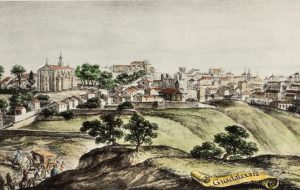This artifact intrigued me not necessarily the word, “uber” which is seen nearly of every street corner of most major U.S. cities today in the form of a car. Rather, what caught my attention was the name, “Guadaljara” which is actually spelled Guadalajara today. This is where my parents were originally born, near a city with a name derived of an Arabic translation, as stated in the official Ayuntamiento de Guadalajara website.
Access: Map of Guadalajara & Zacatecas
“In its distant origins, Guadalajara was linked to Celtoberian culture, though the earliest historical references tell of its strategic military importance to the emirs and caliphs of Córdoba. It was then known as Madinat al-Faray in memory of its conqueror, and Wad al-Hayara, Arab translation of its pre-Roman name, Arriaca.” (Guadalajara.se)
My father actually went to college in Guadalajara, and had essentially gone through what I am experiencing now, “a home away from home.” His decision to sacrifice that education in Guadalajara in Mexico just to seek a better quality life in the United States without citizenship has allowed me to write this blog on this St. Olaf webpage for today. Had he not done so, I would not be here, in this very moment, writing this blog. Now you see why Guadalajara caught my attention. This city’s name creates an emotional response in myself because it symbolizes my family’s origins.
The map is a piece of cartography recorded in 1832 and completed in 1855 by German explorer, Carl de Berghes. One can easily (not actually) identify this source by its title, “Beschreibung der Ueberreste Aztekischer Niederlassungen auf ihrer Wanderung nach dem Thale von Mexico durch den gegenwärtigen Freistaat von Zacatecas”
According to a dear friend and Berlin, Germany native, Leander Krawinkel, the title translates into — “The Map which shows the directions and through which ways the Aztecs emigrated to Mexico” Aztecs were a group of the indigenous peoples who occupied a majority of the territory of today’s Mexico. By this account, it is fair to state that this was one explorer’s observation of how the indigenous people lived and traveled in their land. However, one may be skeptical of Berghes’s perspective on these people’s reason for migrating.
In this following image of a map titled, “Mexico, Texas und Californien” by a German explorer, Heinrich Kiepert indicates the different locations of French and German colonies near Mexico. This is significant because it is a clear reminder to all that that which makes up today’s Mexicans ethnically, around the world and especially the United States, is not just Spanish and Aztec blood, but also German and French blood, as evidenced in the presence of these European explorers in these areas. These cultural encounters were written solely from the perspective of the European explorer’s eye. This blog analysis should aid in the modern Mexican and white-American community’s understanding of their ethnic diversity and similarities as a whole, in hopes of encouraging a more united attitude rather than a separatist attitude from both cultures in a time of political and racial turmoil.
Sources:
Berghes, Carl de (1792-1869). 1832-1855. Beschreibung der Ueberreste Aztekischer Niederlassungen auf ihrer Wanderung nach dem Thale von Mexico durch den gegenwärtigen Freistaat von Zacatecas [manuscript]. [Manuscript]. At: Place: The Newberry Library. VAULT Ayer MS 1045. Available through: Adam Matthew, Marlborough, American Indian Histories and Cultures, http://www.aihc.amdigital.co.uk/FurtherResources/VisualResources/Image/Ayer_MS_1045/61# Accessed February 20, 2018.
Kiepert, Heinrich, 1818-1899. Mexico, Texas und Californien., map, 1847; Weimar. (texashistory.unt.edu/ark:/67531/metapth231410/:accessed February 20, 2018), University of North Texas Libraries, The Portal to Texas History, texashistory.unt.edu; crediting University of Texas at Arlington Library.
“The history of the city, from the Celtiberian origin until today.” The history of the city, from the Celtiberian origin until today. – Ayuntamiento de Guadalajara. Accessed February 20, 2018. https://www.guadalajara.es/en/tourism/discover-guadalajara/history/.



I am a huge fan of historical maps, so I can’t tell you how excited I am that you chose to write about two maps! I also love how you wove your family’s history into your analysis of the objects, although I’m a little confused about when you’re talking about Guadalajara, Spain and when you’re talking about Guadalajara, Mexico. (If I’m reading this correctly, it seems like you’re exclusively talking about the Mexican placename, but you’re pointing out that even that name is inflected by a history of cultural exchange and ethnic mixture.)
A minor formatting criticism: it would be great if you could eliminate extra whitespace in your post, as that forces people on phones to scroll quite a bit more, and makes the writing feel a bit disjointed. I’d also encourage you to add tags (I can show you how if it’s unclear) and, most importantly, I’d encourage you to connect your writing to course materials and topics as explicitly as possible. For instance, in this case you could point out that just as American music scholars increasingly recognized the hybrid, racially mixed origins of much American music (here you’d cite Nunn, Manuel, etc.), it’s important for Americans to understand that Mexico’s heritage is similarly rich and complicated. You hint at this idea towards the end (and you’re right to recommend this nuanced, critical perspective!) but you could come right out and make the connection with the course explicit. Finally, don’t forget that we’re focusing on music this semester, so while I’m thrilled to see these maps, you should always tie in music or writing about music as a primary source. In your case, you could easily point out that tejano music provides ample evidence of the German influences on Mexican culture, since it draws so heavily on German polka and waltz idioms, and you could cite some scholarship that discusses that influence.
This is a great start! Let me know if you have any questions about my feedback, and keep up the good work!